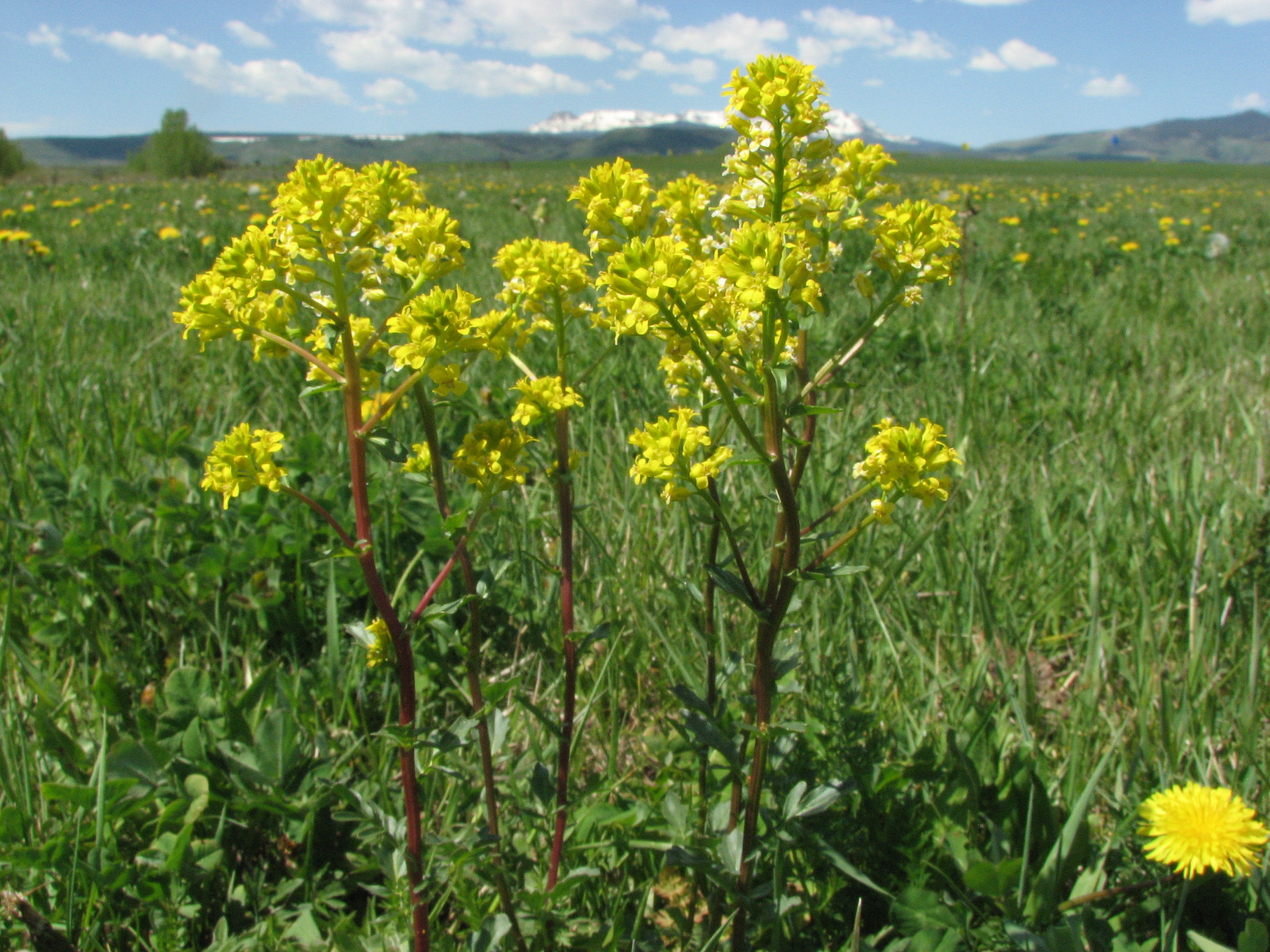Musk Thistle
Carduuas nutans
Keys to Identification
- The waxy leaves are dark green with a light green midrib and mostly white margins
- The large and showy flowers are terminal, flat, nodding, 1-1/2 to 2-1/2 inches across, purple, rarely white, and surrounded by numerous, lance-shaped, spine-tipped bracts
- Blooms appear in late May and June and set seed in June or JuIy
- Musk thistle is commonly found in pastures, roadsides, and waste places. It prefers moist, bottom land soil, but can be found on drier uplands, also. It is becoming an increasing problem throughout Colorado, particularly along the Front Range
This information courtesy of the Colorado Natural Areas Program
Family
Sunflower (Asteraceae)
Other Names
Nodding thistle, nodding plumeless thistle.
USDA Code
CANUM2
Legal Status
Colorado Noxious Weed List B
Identification
Lifecycle
Biennial, or sometimes winter annual.
Growth form
Forb
Flower
Flower heads are terminal, solitary, 1 1/2-3 in wide, and usually nodding. Flowers are deep rose, violet or purple, occasionally white. Flowers have broad, spine-tipped bracts below. May-July.
Seeds/Fruit
One-seeded oblong fruit (achene) about 0.2 inches long, shiny, yellowish-brown with a plume (pappus) of white hair-like bristles.
Leaves
Leaves are alternate, dark green, deeply lobed, and spiny margined. The leaves extend onto the stem giving a winged appearance (Whitson et al. 1996). Basal rosettes are well developed, leaves elliptical to lanceolate, 6-14 in, smooth to densely hairy.
Stems
Mature plants can grow as tall as 6 ft. It can appear solitarily or with several stems from one base, and is highly branched above.
Roots
Fleshy taproot
Similar Species
Exotics
Musk thistle is similar to plumeless thistle(Carduus acanthoides). Rosettes of plumeless thistle are distinguished from those of musk thistle by having leaves that are deeply serrate (saw-toothed) almost to the midrib.
Natives
There are many native thistle species in the genusCirsium. The natives generally do not have leaves clasping the stem all the way from node to node (strongly decurrent leaves), and many have hairy upper and lower leaf surfaces and are blue-green or gray in color.
Impacts
Agricultural
Likely to infest pastures. Is unpalatable to livestock.
Ecological
Musk thistle is a highly competitive weed which invades disturbed areas, pasture, rangeland, forest land, cropland, and waste areas throughout most of the United States. Musk thistle spreads rapidly and forms extensive stands, which force out desirable vegetation (Rutledge and McLendon, 1998). Musk thistle may produce allelopathic chemicals that inhibit desirable plants beyond the spread of the rosettes (Wardle et al. 1993).
Habitat and Distribution
General requirements
Musk thistle does not appear to have any specific climatic requirements other than a cool period of vernalization for flowering (Butterfield et al. 1996). It occurs in areas with as little as 10 in of annual precipitation (FEIS 1998). Musk thistle establishes best on bare soil, and small shallow cracks are ideal for seedling establishment (FEIS 1998). Musk thistle grows in all soil textures, but the soils must be well-drained (Butterfield et al. 1996) It occurs on soils with a pH range of 6.0 to 8.9 (Butterfield et al. 1996).
Distribution
In Colorado, musk thistle is found up to approximately 10,000 feet in elevation (Beck 1999). It is found throughout North America.
Historical
Native to Eurasia.
Biology/Ecology
Life cycle
Seeds germinate in the fall, forming a rosette of leaves. Typically, musk thistle over-winters as a rosette and bolts the following spring between April-June. Flowering begins in late May or early June and continues through mid-July (Butterfield et al. 1996). Seeds mature and are dispersed 1 to 3 weeks after flowering. Seedlings establish only on bare soils and grow less when shaded by neighboring plants (Beck 1999).
Mode of reproduction
Seed.
Seed production
Musk thistle is a prolific seed producer. Average productivity is approximately 10,000 seeds/plant, however, a single plant can produce up to 100,000 seeds (Beck 1999).
Seed bank
Musk thistle seeds appear to remain viable for at least 10 years.
Dispersal
Seed dispersal is by wind water, wildlife and livestock (Beck 1999).
Hybridization
May hybridize with plumeless thistle(Carduus acanthoides).
References
Butterfield, C., J. Stubbendieck, and J. Stumpf. 1996. Species abstracts of highly disruptive exotic plants. Jamestown, ND: Northern Prairie Wildlife Research Center Home Page. www.npwrc.usgs.gov/resource/othrdata/exoticab/exoticab.htm (Version 16JUL97).
FEIS – Fire Effects Information System [Online] (1996, September). Prescribed Fire and Fire Effects Research Work Unit, Rocky Mountain Research Station (producer), US Forest Service. Available:www.fs.fed.us/database/feis/[1998,March 12]
Beck, G. K. 1999. Biennial thistles. In: R.L. Sheley and J.K. Petroff (eds.) Biology and management of noxious rangeland weeds. Oregon State University Press, Corvallis. pp. 145-161.
Desrochers, A.M., J.F. Bain, and S.I. Warwick. 1988. The biology of Canadian weeds, Carduus nutans L. and Carduus acanthoides L. Canadian Journal of Plant Science 68: 1053-1068.
Heidel, B. 1987. Element Stewardship Abstract for Carduus nutans, musk thistle. The Nature Conservancy. Internet 7/30/98. Available: tncweeds.ucdavis.edu/esadocs/documnts/cardnut.html
Louda, S.M., D. Kendall, J. Connor and D. Simberloff. 1997. Ecological effects of an insect introduced for the biological control of weeds. Science 277: 1088-1090.
Rutledge, C. R. and T. McLendon. No Year. An Assessment of Exotic Plant Species of Rocky Mountain National Park. Department of Rangeland Ecosystem Science, Colorado State University. 97pp. Northern Prairie Wildlife Research Center Home Page. www.npwrc.usgs.gov/resource/othrdata/explant.htm (Version 15DEC98).
Wardle, D. A., K. S. Nicholson and A. Rahman. 1993. Influence of plant age on the allelopathic potential of nodding thistle (Carduus nutans) against pasture grasses and legumes. Weed Research 33:69-78.
Whitson, T.D.(ed.), L.C. Burrill, S.A. Dewey, D.W. Cudney, B.E. Nelson, R.D. Lee, R. Parker. 1996. Musk thistle. Weeds of the West. Western Society of Weed Science, in cooperation with the Western United States Land Grant Universities Cooperative Extension Services, Newark CA. pg. 76.


